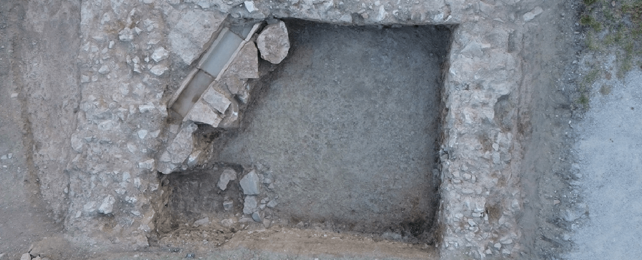A lengthy search for a long-lost building has unearthed the foundations of a 'cult' temple in central Italy beneath a grassed-over parking lot.
The discovery, embellished by a letter from Roman times describing the building's construction, suggests the Empire's transition from paganism to Christianity was not so straightforward, but rather slow and a bit messy.
"We found three walls of a monumental structure that evidence suggests belonged to a Roman temple that dates to Constantine's period," says Douglas Boin, an archeologist at Saint Louis University in Missouri.
Constantine, also known as Constantine the Great, was the first Roman emperor to convert to Christianity, some 70 years before it became the official religion of the Roman Empire in 380 CE.
Before this cultural conversion, people tended to worship a pantheon of pagan gods. But in the ruins of this new-found buried temple, Boin and his colleagues believe they have found evidence of a transitional period, when people worshiped an imperial cult under a Christian ruler, Constantine.
Not to be confused with cults in the modern sense, here cult refers to religious practices where people worshipped an emperor or a dynasty of rulers as demigods or deities.
Given Constantine followed a monotheistic faith featuring one all-powerful god, his encouragement of such ancestral worship is as contradictory as it is revealing.
"It shows the continuities between the classical pagan world and early Christian Roman world that often get blurred out or written out of the sweeping historical narratives," says Boin, who announced the discovery at the Archeological Institute of America's annual meeting in January.
"We've known that pagans worshiped at their temples in the fourth century, but those findings have all been small and inconsequential," Boin continues.
"And we've known that Christians supported the imperial cult… without any sense of where it would have happened. This temple bridges those two landmarks."
Starting in 2021, Boin collaborated with a team of Italian archeologists – including Letizia Ceccarelli of the Polytechnic University of Milan – in search of a temple described by Constantine in a 4th-century letter to the townspeople of Spello, which today is located about 150 kilometers (just over 90 miles) north of modern-day Rome.
In the letter, which was discovered in the 18th century, Constantine instructed Spello residents to build an imperial cult temple in his honor. However, this building "has never definitively been located," the researchers write in their conference paper.
Using remote-sensing technologies such as magnetometry and ground-penetrating radar, the team set to work surveying the hillsides around Spello, looking for buried architectural remains that could be Constantine's temple.
Their investigations pointed toward the grounds of the Renaissance-era Villa Fidelia where preliminary excavations revealed the foundations of a large, potentially Roman-era building which the researchers describe as a "monumental" find.
It's unclear though what other archeologists might think of the architectural remains, and if the claims about the site's significance will hold, as excavations aren't yet complete and the team's work hasn't been peer-reviewed.
"We are on the cusp of giving people a very visible piece of evidence that really upends the neat and tidy ways people think about big moments of cultural change," says Boin.
"Cultural changes are never as big as we think they are when living through them, and there's a lot of gray area in between people's customs and the broader society and culture."
"So to have this temple potentially be a temple dedicated to Constantice's divine ancestors as a way to worship the emperor in an increasingly Christian world at the time, it's so weird and I love that we can bring it to light."
